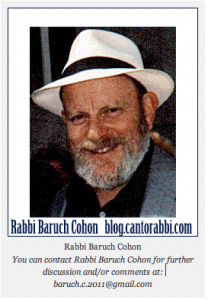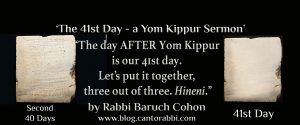THE 41ST DAY – a Yom Kippur sermon by Rabbi Baruch Cohon
Forty days ago was the first of Elul – Elul, the month of preparation for the High Holidays. That makes tomorrow the 41st day. But wait a minute. We had just One Month to prepare ourselves for a new year. One month? Is that enough?
This year I’d like to offer an alternate view.
True, our tradition calls for the shofar to be sounded every morning from the first of Elul until Rosh HaShanah, to remind us of the coming Divine judgment. But that’s only the immediate alert – like the siren calling Israelis to the bomb shelters. From the viewpoint of biblical history, our days of preparation should last all summer. Let’s check the dates.
Shavuot, the Festival that comes seven weeks after the second Seder, commemorates receiving the Torah at Mount Sinai. It takes place on the 6th day in Sivan (this year May 31st). That was the beginning of the experience. First, our ancestors heard the thunder, saw the lightning, got the message of the Ten Commandments – and then Moses climbed the mountain. He stayed there for 40 days, came down with the two Tablets of the Law, saw the Jews dancing around the Golden Calf, and smashed the tablets. That tragic event took place on the eve of the 17th of Tamuz, and was only the first of several historic disasters associated with that date. Still observed as a fast day, the 17th of Tamuz this year coincided with July 11th. The following day, the 41st day after Shavuot, Moses offers a prayer of desperation and is invited back up the mountain.
Another 40 days pass. As Rabbi Yonason Goldson points out, this was a period of prayer. No tablets. Again Moses returns to report to the people that the Almighty accepted his prayer, and will forgive them. He returned on the last day of the month of Av (this year August 22nd).
Now Moses gets the message to carve out two new stone tablets, carry them up the mountain, and then G-d will inscribe them with the same words that were on the broken tablets. Moses does so. After a third stay of 40 days on Mount Sinai he brings down the tablets intact. Count 40 days from the first day of Elul, and you come to the 10th day in Tishri, otherwise known as Yom Kippur.
So our ancestors finally received – and accepted — the Torah, not on Shavuot but today – on Yom Kippur. And what does that signify for us?
We could sum up the answer in one word: Hineni. When summoned to duty, it is the reply of every faithful Jew from Abraham to Moses to the cantor at Musaf time, to the soldier on the West Bank: Hineni – one Hebrew word that combines three concepts, and is accordingly translated by three English words: Here I am. Here is the place. I am the one. Now is the time.
We face these challenges in our daily lives. All three of them.
Yes, we should learn Torah. We should bring our heritage into our family life. Yes, opportunities are available to do that, right here where we live. But not right now… I’m busy… maybe later after I retire.
Two out of three doesn’t make it.
Yes, we get appeals from good causes that need our help – from food banks to war relief to medical research to education to congregational programs. We see opportunities for service, and yes, we write a check. But put in some time right here? Maybe not.
Again it’s two out of three.
Other challenges face us, in the community and in the world at large. How do we use energy? Do we identify the source of merchandise before we buy? Do we take the trouble to think about those daily decisions, or do we leave them to other people? Here and now, but not me. Reminds us of some national policies: yes, al Qaeda should be stopped; yes, Hizbollah should be disarmed – by someone else…
Two out of three.
Those same three components of Hineni show up in the 120-day buildup to the New Year. Apply them to Moses at Mount Sinai:
The first 40 days encouraged the Here. Here is the place. Sinai was the place for revelation. Look what the Almighty is giving us! But the people couldn’t see the top of the mountain. They missed the Here. They were afraid Moses would not come back, so they turned to idolatry. Came the 41st day, and disaster.
The second 40 days expressed the Now. Now is the time. “This is Your people whom You freed from Egypt,” Moses prayed. “Don’t destroy them now! Forgive them, now!” And he brought back the assurance of Divine compassion in the 13 attributes of G-d, to give the people back their courage: “The Lord, the Lord is a G-d merciful and gracious, long-suffering and abundant in kindness…” This time, the 41st day brought a challenge: You want the Torah? Carve your own tablets.
Only then did the third and final preparation period begin. Human effort brought cosmic fulfillment. I am the one. Even if it means hard work. Even if it means spending Rosh HaShanah on the mountain top. Maybe Moses heard the shofar sounded in the valley below, maybe not. But on that first Yom Kippur he brought us the visible, tangible presence of our heritage.
That Yom Kippur, as every Yom Kippur, was the 40th day. Moses rose to his challenge and won his reward. Each one of us faces a similar challenge. Here is the place. Now is the time. I am the one.
The day AFTER Yom Kippur is our 41st day. Let’s put it together, three out of three. Hineni.
Ken y’hi ratzon.



